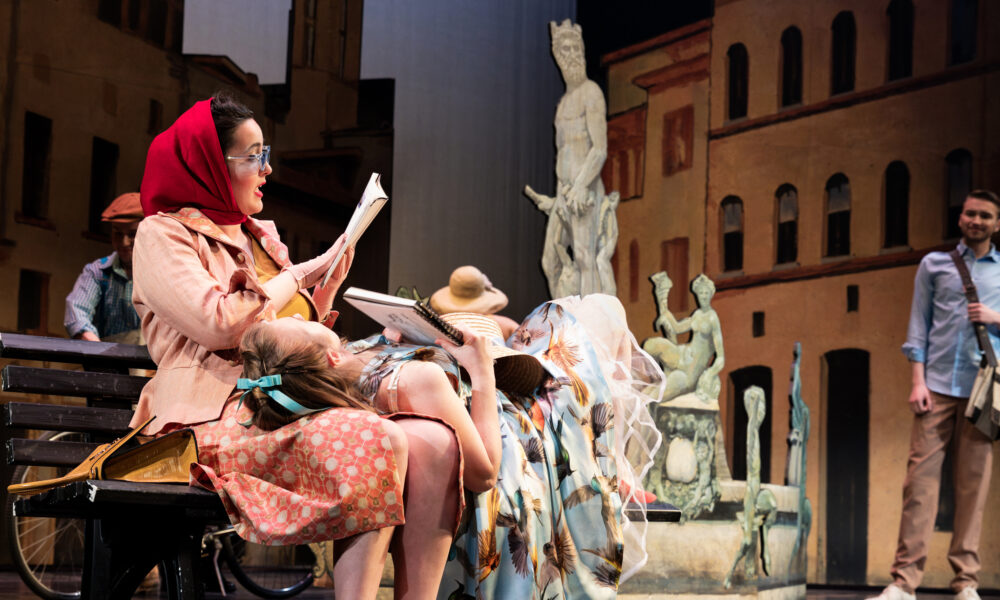Love and acceptance—our primal desires—are laid bare in Opera McGill and McGill Symphony Orchestra’s opening night production of Adam Guettel’s The Light in the Piazza. The story explores love and hope through the intercultural romance between Clara, an American, and Fabrizio, an Italian. The plot is layered and complex, yet remains comedic and focused, thanks to the excellent cast and soaring melodies.
Kate Fogg, M2 Music, delivered a gripping and beautiful rendition of Clara, a young woman who suffered a brain injury as a child, limiting her emotional and mental development. Fogg’s gentle yet brilliant voice encapsulated the dichotomy between Clara’s youthful demeanour and the fierce emotions that burgeon as she embarks on a life for herself without her mother.
Though the romance between Clara and Fabrizio (Kyle Briscoe, M2 Music) was playful, and the blending of their voices was mesmerizing, I found the relationship between Clara and her mother Margaret (MacKenzie Sechi, M2 Music) to be the most compelling. The deep love between Clara and Margaret remained at the heart of their struggles with independence and identity. Fogg and Sechi were able to display these intricacies through their nuanced performances, revealing that their close bond was forever at odds with their respective individuality.
Despite being partially in Italian, the show overcame the language barrier through the cast’s expressiveness. The operatic Italian songs suited the classically trained cast and showed an impressive grasp of not only Italian but Italian-accented English. The cast of the Naccarellis—Fabrizio’s family—did an exceptional job. Their Italian was precise and convincing, yet I understood each scene through their gesturing and expression. Giuseppe (Christopher Pitre-McBride, M1 Music), had an electric stage presence and comedic timing, making his scenes especially memorable.
Though the show contained serious subject matter—struggles with mental disabilities and marital disappointment—it remained funny and captivating. The staging, costuming, and lighting, under the direction of David Gately, worked together to bring out the melange of cultures in the narrative. Many scenes were staged like a tableau vivant in the style of the Florentine Renaissance artwork that surrounds the characters. The costuming was remarkable, transforming the stage into a parade of 1950s fashion that subtly highlighted the cultural differences between the Americans’ casual vacation wear and the Italians’ sophisticated dresswear.
The use of spotlights was particularly effective at bringing out the relationships between characters. While other characters’ soft spotlights placed them within the amber lighting of the stage, Clara’s father was under harsh white lighting that alienated him from the setting. On his final phone call to his wife, he paced desperately between the confines of his spotlight as he learned he would not be able to stop his daughter’s wedding.
Even though musicals are outside the usual repertoire of McGill Opera students, their execution was true to the style of the piece.
“Opera has changed. There’s been a big shift in the repertoire that opera companies are doing,” Patrick Hansen, the Artistic Director of Opera McGill, said in an interview with The Tribune.
The Light in the Piazza acts as a way to prepare students for the opera world’s changing landscape. While this piece is a musical, operatic elements come through in the orchestration, wide singing range, and Italian traditions that make it uniquely powerful. These elements were able to bring out the larger-than-life emotions of Clara’s newfound freedom, breathing new life into familiar themes of traditional musicals. The orchestra, conducted by Jonathan Monro, played beautifully, balancing the difficult act of expressively playing the phrases without overpowering the singers or the dialogue. The striking orchestration and use of coloratura register evoked the dramaticism of young love and emphasized Clara’s deep desire for acceptance.
In the final moments of the show, Margaret faced the audience and finally embraced the promise of Clara’s future, closing with a beautifully haunting plea for the light of her love to never dim in a moving declaration of hope.







